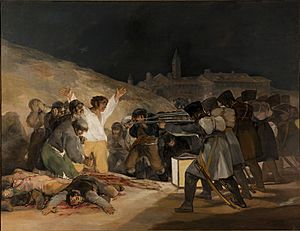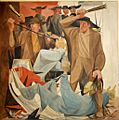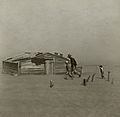Social realism facts for kids

Social realism is a type of art, stories, movies, and plays. It shows the everyday lives of ordinary people. This often includes workers and people who are not rich. Artists who use social realism want to show things as they really are. They might show people who are old, sick, or sad. Even if the subject isn't "beautiful," the art itself can still be very powerful and well-made.
Social realism isn't just from one time period. Artists from different centuries and countries have used this style.
Contents
Famous Social Realist Artists
Many famous artists have used social realism. Caravaggio, a painter from the late Renaissance period, created "realist" pictures.
Several Spanish painters were also "realists." These include Velazquez, Esteban Murillo, and Francisco de Goya.
In the 19th century, many painters used this style. Some well-known ones were Gustave Courbet from France and Luke Fildes from England.
Social Realism Around the World
Social realism was very popular in Russian art and literature. In the 20th century, it became the main type of art in the Soviet Union.
The artist David Siqueiros also used social realism. He showed the daily struggles of people in his country, Mexico.
Other pages
Images for kids
-
Grant Wood's most famous work, American Gothic, 1930. It is a well-known example of social realism.
-
Gustave Courbet, A Burial At Ornans
-
Dorothea Lange, Migrant Mother, 1936. This photo shows Florence Owens Thompson and is a famous image of The Great Depression.
-
Anton Refregier's mural Beating the Chinese in San Francisco. It shows the violence during the San Francisco riot of 1877.
-
Ilya Repin, Barge Haulers on the Volga 1870–1873.
-
Thomas Hart Benton, People of Chilmark, 1920, Hirshhorn Museum and Sculpture Garden, Washington, DC.
-
Maxine Albro, California (mural), 1934, Coit Tower, San Francisco.
-
Walker Evans, Floyd Burroughs, Alabama cotton Sharecropper, Hale County, Alabama, around 1935–1936.
-
Ben Shahn, Detail of The Passion of Sacco and Vanzetti (1967, mosaic), Syracuse University, Syracuse, NY.
-
Walker Evans, Allie Mae Burroughs, Wife of a Cotton Sharecropper, Hale County, Alabama, around 1935–1936.
-
Arthur Rothstein, A Farmer and His Two Sons During a Dust Storm, Cimarron County, Oklahoma, 1936. This photo is a symbol of the Dust Bowl.
-
Diego Rivera, Recreation of Man at the Crossroads (renamed Man, Controller of the Universe), originally from 1934.
-
Constantin Meunier, Miner at the Exit of the Shaft, 1880s, Meunier Museum, Brussels.
See also
 In Spanish: Realismo social para niños
In Spanish: Realismo social para niños


















